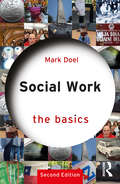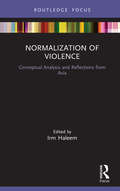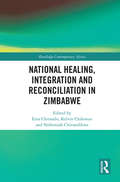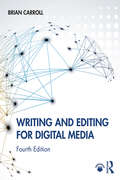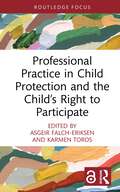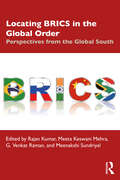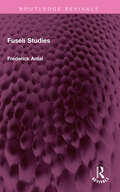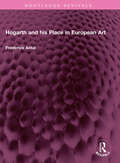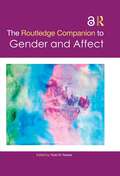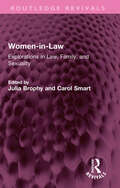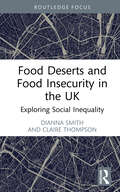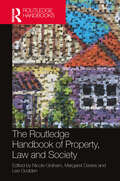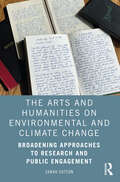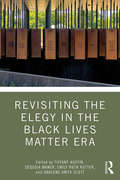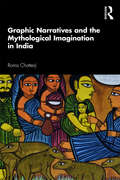- Table View
- List View
Social Work: The Basics (The Basics)
by Mark DoelThis revised second edition of Social Work: The Basics is an insightful introduction to the often misrepresented world of social work. This accessible book presents a broad view of contemporary social work, exploring its roots and its possible future. It dispels myths surrounding social work, addresses media debates, and offers a balanced account of what social workers do. Arguing for a social work that is partisan in support of social justice, questions covered include: How did social work arise? How and why do people come into contact with social workers? What are the true aims of social work – to help or to control? What is the relationship between social work and social policy? How and why do people become social workers? What’s it like to be a social worker? Can social work cross borders? Drawing examples from the full range of social work practice, this book is valuable reading for all individuals interested in the field of social work. It will provide a helpful introduction for students considering a career in social work, those beginning social work courses, and other professionals whose work brings them into contact with social workers.
Normalization of Violence: Conceptual Analysis and Reflections from Asia (Routledge Contemporary Asia Series)
by Irm HaleemThis book offers both a conceptual and an empirical analysis of how violence is normalized. In its conceptual analysis, Irm Haleem offers a framework of explanation that she argues is universal in its narratives, which she submits is premised on moralizing, legalizing, and popularizing violence. Haleem engages Stathis Kalyvas’s notion of the two stages of violence (process and outcome), and proposes the notion of "metaphysical" violence as distinct from physical violence. Through drawing upon works of scholars such as Hannah Arendt, Noam Chomsky, W.J.T. Mitchell, Michel Foucault, Jacques Derrida, George Kateb, and others, she illustrates why these distinctions (of stages and types of violence) are critical in understanding how violence is normalized. In its empirical analysis, Naoko Kumada argues that the contemporary changes in narratives and educational curriculum in Japan are intended to moralize the historic glory days of imperial Japan, which, she argues, may subsequently normalize militarism. Stefanie Kam focuses on how China has normalized violence in Xinjiang through narratives of the imperatives of security, thereby both legalizing and moralizing violence. Jennifer Dhanaraj argues how the denial of citizenship to the Rohingya community in Myanmar has provided both the moral and legal justifications for Buddhist extremists and the military to wage a brutal and unbridled war against the Rohingyas. Finally, Abdul Basit examines how the ex-communication of the Ahmadi sectarian minority in Pakistan has criminalized the minority, thus paving the way for unbridled violence against them from extremist mobs that have justified their violence in moral and legal terms. In all the cases in this book, we see how violence is popularized as being either a matter of the will of the people, or as being for the greater good of the people.
National Healing, Integration and Reconciliation in Zimbabwe (Routledge Contemporary Africa)
by Ezra ChitandoThis book brings together scholars from diverse backgrounds to provide interdisciplinary perspectives on national healing, integration, and reconciliation in Zimbabwe. Taking into account the complex nature of healing across moral, political, economic, cultural, psychological, and spiritual dimensions of communities and the nation, the chapters discuss approaches, disparities, tensions, and solutions to healing and reconciliation within a multidisciplinary framework. Arguing that Zimbabwe’s development agenda is severely compromised by the dominance of violence and militancy, the contributors analyse the challenges, possibilities and opportunities for national healing. This book will be of interest to scholars of African studies, conflict and reconciliation, and development studies.
Writing and Editing for Digital Media
by Brian CarrollIn this new edition, Brian Carroll explores writing and editing for digital media with information about voice, style, media formats, and content development, combining hands-on exercises with new sections on idea generation, multi-modal storytelling, podcasting, and information credibility. Carroll explains and demonstrates how to effectively write for digital spaces – whether crafting a story for a website, writing for an app, blogging, or using social media to expand the conversation. Each chapter features lessons and exercises through which students can build a solid understanding of the ways that digital communication provides opportunities for dynamic storytelling and multi-directional communication. Updated with contemporary examples and new pedagogy, the fourth edition broadens its scope, helping digital writers and editors in all fields, including public relations, marketing, and social media management. Writing and Editing for Digital Media is an ideal handbook for students from all backgrounds who are looking to develop their writing and editing skills for this ever-evolving industry.
Social Work: The Basics (The Basics)
by Mark DoelThis revised second edition of Social Work: The Basics is an insightful introduction to the often misrepresented world of social work. This accessible book presents a broad view of contemporary social work, exploring its roots and its possible future. It dispels myths surrounding social work, addresses media debates, and offers a balanced account of what social workers do. Arguing for a social work that is partisan in support of social justice, questions covered include: How did social work arise? How and why do people come into contact with social workers? What are the true aims of social work – to help or to control? What is the relationship between social work and social policy? How and why do people become social workers? What’s it like to be a social worker? Can social work cross borders? Drawing examples from the full range of social work practice, this book is valuable reading for all individuals interested in the field of social work. It will provide a helpful introduction for students considering a career in social work, those beginning social work courses, and other professionals whose work brings them into contact with social workers.
Professional Practice in Child Protection and the Child’s Right to Participate (The Focus On Series)
by Karmen Toros Asgeir Falch-EriksenThis book explains and discusses how a child’s right to freedom of expression is upheld through practice and decision-making in Child Protection Services (CPS). Using the right to expression as stipulated in Article 12.2 of the United Nations Convention on the Rights of the Child (CRC) as a point of departure, it explains what CPS practices should look like and how they must operate to uphold and enforce the rights of the child by providing "the opportunity to be heard" in any administrative practice. Current research literature documents extensively, and across countries, how either the voice of the child is not heard or, alternatively, the existence of a pro forma/tokenistic approach to listening to the child throughout CPS practices. Taking a three-fold approach, this book establishes a clearer connection between rights and professional practice according to Article 12 extrapolates how rights-based practice is achieved during CPS practices provides a comprehensive answer to the challenge of implementing Article 12.2 through policy and legislation. It will be of interest to all students, academic and professionals working within child protection including social workers, probation officers, health and social care workers, lawyers and teachers.
Professional Practice in Child Protection and the Child’s Right to Participate (The Focus On Series)
by Asgeir Falch-Eriksen Karmen TorosThis book explains and discusses how a child’s right to freedom of expression is upheld through practice and decision-making in Child Protection Services (CPS). Using the right to expression as stipulated in Article 12.2 of the United Nations Convention on the Rights of the Child (CRC) as a point of departure, it explains what CPS practices should look like and how they must operate to uphold and enforce the rights of the child by providing "the opportunity to be heard" in any administrative practice. Current research literature documents extensively, and across countries, how either the voice of the child is not heard or, alternatively, the existence of a pro forma/tokenistic approach to listening to the child throughout CPS practices. Taking a three-fold approach, this book establishes a clearer connection between rights and professional practice according to Article 12 extrapolates how rights-based practice is achieved during CPS practices provides a comprehensive answer to the challenge of implementing Article 12.2 through policy and legislation. It will be of interest to all students, academic and professionals working within child protection including social workers, probation officers, health and social care workers, lawyers and teachers.
Locating BRICS in the Global Order: Perspectives from the Global South
by Rajan Kumar Meeta Keswani Mehra G. Venkat Raman Meenakshi SundriyalBRICS is conceivably the most formidable organisation to have emerged in the post-Cold War period in the non-Western world. This book highlights the significance of BRICS in a wider global context and foregrounds the long-pending demand for the reform of global governance institutions. The volume: • Traces how the organisation came into being and looks at the distinct norms and principles espoused by it • Discusses the glaring limitations of the existing institutions of global governance • Explores the economic growth and the rising political influence of BRICS states • Analyses the internal threats to the survival of the organisation and assesses its prospects in the foreseeable future. A significant intervention in situating BRICS as one of the major players in global governance, the book will be of great interest to students and scholars of international political economy, international business and finance, international relations, politics, and Global South Studies.
Locating BRICS in the Global Order: Perspectives from the Global South
by Rajan Kumar Meeta Keswani Mehra G. Venkat Raman Meenakshi SundriyalBRICS is conceivably the most formidable organisation to have emerged in the post-Cold War period in the non-Western world. This book highlights the significance of BRICS in a wider global context and foregrounds the long-pending demand for the reform of global governance institutions. The volume: • Traces how the organisation came into being and looks at the distinct norms and principles espoused by it • Discusses the glaring limitations of the existing institutions of global governance • Explores the economic growth and the rising political influence of BRICS states • Analyses the internal threats to the survival of the organisation and assesses its prospects in the foreseeable future. A significant intervention in situating BRICS as one of the major players in global governance, the book will be of great interest to students and scholars of international political economy, international business and finance, international relations, politics, and Global South Studies.
Fuseli Studies (Routledge Revivals)
by Frederick AntalFirst published in 1956, Fuseli Studies deals with the many-sided artistic achievements of Zurich-born Fuseli’s baffling personality, who was one of the most erudite and renowned intellectuals of his day in Europe. The author’s intention has been to place his subject in clear historical perspective within his own epoch, and thus traces Fuseli’s contacts back to sixteenth-century mannerism and forward to twentieth-century expressionism. In this book, the social background of that absorbing period covering the artist’s working years at the turn of the nineteenth century is evoked not only in analysing his style, poised between classicism and romanticism of the age, but also accounting for its appeal and relevance to the present day. This book will be of interest to students of art, art history, European history, and literature.
Hogarth and his Place in European Art (Routledge Revivals)
by Frederick AntalFirst published in 1962, Hogarth and his Place in European Art attempts to convey the historical relevance, both in its native and European context, of perhaps the most outstanding English painter of the eighteenth century. Dr. Antal applies his method of establishing the close relationship between the political and social history and the arts and letters of the period. Thus, the book goes far beyond the limits of art historical appreciation. It gives a panoramic picture of the first half of the eighteenth century in England with all its social, literary, and artistic connotations. He shows how England, which during those years became both politically and economically the most advanced country in Europe, could provide in Hogarth, in spite of the slender native tradition, the most progressive artistic personality of his time – whose work revealed the views and tastes of a broad cross-section of society. He traces Hogarth’s stylistic origins back to their European sources and analyses his impact on contemporary European and English art as well as the influence he exerted on generations to come. This book will be of interest to students of art, art history, literature, and European history.
Fuseli Studies (Routledge Revivals)
by Frederick AntalFirst published in 1956, Fuseli Studies deals with the many-sided artistic achievements of Zurich-born Fuseli’s baffling personality, who was one of the most erudite and renowned intellectuals of his day in Europe. The author’s intention has been to place his subject in clear historical perspective within his own epoch, and thus traces Fuseli’s contacts back to sixteenth-century mannerism and forward to twentieth-century expressionism. In this book, the social background of that absorbing period covering the artist’s working years at the turn of the nineteenth century is evoked not only in analysing his style, poised between classicism and romanticism of the age, but also accounting for its appeal and relevance to the present day. This book will be of interest to students of art, art history, European history, and literature.
Hogarth and his Place in European Art (Routledge Revivals)
by Frederick AntalFirst published in 1962, Hogarth and his Place in European Art attempts to convey the historical relevance, both in its native and European context, of perhaps the most outstanding English painter of the eighteenth century. Dr. Antal applies his method of establishing the close relationship between the political and social history and the arts and letters of the period. Thus, the book goes far beyond the limits of art historical appreciation. It gives a panoramic picture of the first half of the eighteenth century in England with all its social, literary, and artistic connotations. He shows how England, which during those years became both politically and economically the most advanced country in Europe, could provide in Hogarth, in spite of the slender native tradition, the most progressive artistic personality of his time – whose work revealed the views and tastes of a broad cross-section of society. He traces Hogarth’s stylistic origins back to their European sources and analyses his impact on contemporary European and English art as well as the influence he exerted on generations to come. This book will be of interest to students of art, art history, literature, and European history.
The Routledge Companion to Gender and Affect (Routledge Companions to Gender)
by Todd W. ReeserThe study of affect is one of the most exciting and wide-ranging topics to have emerged in the humanities and social sciences in recent years and continues to generate research and debate. It has particularly important implications for the study of gender, as this outstanding handbook amply demonstrates. It is the most comprehensive volume to date, engaging with the intersections between gender and affect studies. A global and interdisciplinary range of contributors articulate the connections (and disconnections) between gender, sexuality, and affect in a range of geographical and historical contexts. Comprising over 40 chapters, the Companion is divided into six parts: Affects of Gender, Affective Relations, Relational Affects, Affective Practices, Representing Affects, Geographical and Spatial Affects, Affects of History, Histories of Affect. Topics examined include intersections between gender and affect over topics including queerness, trans*, feminism, masculinity, race/ethnicity, disability, animality, media, posthumanism, technology, sound, labor, neoliberalism, protest, and temporality. This is an outstanding collection that will be invaluable to scholars and students across a range of disciplines, including gender and sexuality studies, cultural studies, literature, media, and sociology.
The Routledge Companion to Gender and Affect (Routledge Companions to Gender)
by Todd W. ReeserThe study of affect is one of the most exciting and wide-ranging topics to have emerged in the humanities and social sciences in recent years and continues to generate research and debate. It has particularly important implications for the study of gender, as this outstanding handbook amply demonstrates. It is the most comprehensive volume to date, engaging with the intersections between gender and affect studies. A global and interdisciplinary range of contributors articulate the connections (and disconnections) between gender, sexuality, and affect in a range of geographical and historical contexts. Comprising over 40 chapters, the Companion is divided into six parts: Affects of Gender, Affective Relations, Relational Affects, Affective Practices, Representing Affects, Geographical and Spatial Affects, Affects of History, Histories of Affect. Topics examined include intersections between gender and affect over topics including queerness, trans*, feminism, masculinity, race/ethnicity, disability, animality, media, posthumanism, technology, sound, labor, neoliberalism, protest, and temporality. This is an outstanding collection that will be invaluable to scholars and students across a range of disciplines, including gender and sexuality studies, cultural studies, literature, media, and sociology.
Women-in-Law: Explorations in Law, Family, and Sexuality (Routledge Revivals)
by Julia Brophy Carol SmartFirst published in 1985, Women-in-Law is a collection of essays examining the complex interactions of law, sexuality, and the family. It explores the ways in which legal ideology and practice affect women and looks at issues such as child custody, domestic violence and prostitution in the light of new research. The contributors review the history of feminist involvement with the law and analyse the law’s fundamental failure to improve the status of women. They also assess strategies for change in view of the current backlash against women’s rights and the traditional role of law in the subjugation of women. This book will be of interest to students of law, political science, sociology, gender studies, and sexuality studies.
Women-in-Law: Explorations in Law, Family, and Sexuality (Routledge Revivals)
by Julia Brophy Carol SmartFirst published in 1985, Women-in-Law is a collection of essays examining the complex interactions of law, sexuality, and the family. It explores the ways in which legal ideology and practice affect women and looks at issues such as child custody, domestic violence and prostitution in the light of new research. The contributors review the history of feminist involvement with the law and analyse the law’s fundamental failure to improve the status of women. They also assess strategies for change in view of the current backlash against women’s rights and the traditional role of law in the subjugation of women. This book will be of interest to students of law, political science, sociology, gender studies, and sexuality studies.
Food Deserts and Food Insecurity in the UK: Exploring Social Inequality (Routledge Focus on Environment and Sustainability)
by Dianna Smith Claire ThompsonThis book examines the social inequalities relating to food insecurity in the UK, as well as drawing parallels with the US. Access to food in the UK, and especially access to healthy food, is a constant source of worry for many in this wealthy country. Crises, such as the COVID-19 pandemic, have coincided with a steep rise in the cost of living, meaning household food insecurity has become a reality for many more households. This book introduces a new framework to examine the many influences on local-level food inequalities, whether they result from individual circumstances or where a person lives. The framework will allow researchers new to the field to consider the many influences on food security, and to support emerging research around different sub-topics of food access and food security. Providing a thorough background to two key concepts, food deserts and food insecurity, the book documents the transition from area-based framing of food resources, to approaches which focus on household food poverty and the rise of food banks. The book invites researchers to acknowledge and explore the ever changing range of place-based factors that shape experiences of food insecurity: from transport and employment to rural isolation and local politics. By proposing a new framework for food insecurity research and by drawing on real-world examples, this book will support academic and applied researchers as they work to understand and mitigate the impacts of food insecurity in local communities. This book will be of great interest to students and scholars of food and nutrition security, public health, and sociology. It will also appeal to food policy professionals and policymakers who are working to address social inequalities and improve access to healthy and nutritious food for all.
The Routledge Handbook of Property, Law and Society
by Nicole Graham, Margaret Davies and Lee GoddenThis handbook brings together diverse perspectives, major topics, and multiple approaches to one of the biggest legal institutions in society: property. Property touches on many fundamental human questions. It involves decisions about power, economy, morality, work, and ecology. It also involves ideas about where humans fit in the world and how humans relate to more-than-human life. This book will ask in myriad ways such questions as: what property means, what kinds of property there are, what is and should be the relationship between owned and owner, and what is the impact of different forms of property on life in this world? Drawing on a range of socio-legal and empirical methodologies, renowned scholars and rising stars in property from around the world present current issues and map future directions in research. Coming from the place of law but reaching out through cognate disciplines, this handbook provides a comprehensive and accessible survey of current research at the interface of property, society, and the environment. This handbook will appeal to students and researchers across a range of disciplines, including law, sociology, geography, history, and economics.
Food Deserts and Food Insecurity in the UK: Exploring Social Inequality (Routledge Focus on Environment and Sustainability)
by Dianna Smith Claire ThompsonThis book examines the social inequalities relating to food insecurity in the UK, as well as drawing parallels with the US. Access to food in the UK, and especially access to healthy food, is a constant source of worry for many in this wealthy country. Crises, such as the COVID-19 pandemic, have coincided with a steep rise in the cost of living, meaning household food insecurity has become a reality for many more households. This book introduces a new framework to examine the many influences on local-level food inequalities, whether they result from individual circumstances or where a person lives. The framework will allow researchers new to the field to consider the many influences on food security, and to support emerging research around different sub-topics of food access and food security. Providing a thorough background to two key concepts, food deserts and food insecurity, the book documents the transition from area-based framing of food resources, to approaches which focus on household food poverty and the rise of food banks. The book invites researchers to acknowledge and explore the ever changing range of place-based factors that shape experiences of food insecurity: from transport and employment to rural isolation and local politics. By proposing a new framework for food insecurity research and by drawing on real-world examples, this book will support academic and applied researchers as they work to understand and mitigate the impacts of food insecurity in local communities. This book will be of great interest to students and scholars of food and nutrition security, public health, and sociology. It will also appeal to food policy professionals and policymakers who are working to address social inequalities and improve access to healthy and nutritious food for all.
The Routledge Handbook of Property, Law and Society
by Nicole Graham Margaret Davies Lee GoddenThis handbook brings together diverse perspectives, major topics, and multiple approaches to one of the biggest legal institutions in society: property. Property touches on many fundamental human questions. It involves decisions about power, economy, morality, work, and ecology. It also involves ideas about where humans fit in the world and how humans relate to more-than-human life. This book will ask in myriad ways such questions as: what property means, what kinds of property there are, what is and should be the relationship between owned and owner, and what is the impact of different forms of property on life in this world? Drawing on a range of socio-legal and empirical methodologies, renowned scholars and rising stars in property from around the world present current issues and map future directions in research. Coming from the place of law but reaching out through cognate disciplines, this handbook provides a comprehensive and accessible survey of current research at the interface of property, society, and the environment. This handbook will appeal to students and researchers across a range of disciplines, including law, sociology, geography, history, and economics.
The Arts and Humanities on Environmental and Climate Change: Broadening Approaches to Research and Public Engagement
by Sarah SuttonThe Arts and Humanities on Environmental and Climate Change examines how cultural institutions and their collections can support a goal shared with the scientific community: creating a climate-literate public that engages with environmental issues and climate change in an informed way. When researchers, curators, and educators use the arts and humanities to frame discussions about environmental and climate change, they can engage a far wider public in learning, conversation, and action than science can alone. Demonstrating that archival and object-based resources can act as vital evidence for change, Sutton shows how the historical record, paired with contemporary reality, can create more personal connections to what many consider a remote experience: the changing climate. Providing valuable examples of museum collections used in discussions of environmental and climate change, the book shares how historic images and landscape paintings demonstrate change over time; and how documentary evidence in the form of archaeological reports, ships logs, Henry David Thoreau’s journals, and local reports of pond hockey conditions are being used to render climate data more accessible. Images, personal records, and professional documents have critical roles as boundary objects and proxy data. These climate resources, Sutton argues, are valuable because they make climate change personal and attract a public less interested in a scientific approach. This approach is underused by museums and their research allies for public engagement and for building institutional relevancy. The Arts and Humanities on Environmental and Climate Change will be most interesting to readers looking for ways to broaden engagement with environmental and climate issues. The ideas shared here should also act as inspiration for a broad spectrum of practitioners, particularly those writing, designing, and curating public engagement materials in museums, for wider research, and for the media.
The Arts and Humanities on Environmental and Climate Change: Broadening Approaches to Research and Public Engagement
by Sarah SuttonThe Arts and Humanities on Environmental and Climate Change examines how cultural institutions and their collections can support a goal shared with the scientific community: creating a climate-literate public that engages with environmental issues and climate change in an informed way. When researchers, curators, and educators use the arts and humanities to frame discussions about environmental and climate change, they can engage a far wider public in learning, conversation, and action than science can alone. Demonstrating that archival and object-based resources can act as vital evidence for change, Sutton shows how the historical record, paired with contemporary reality, can create more personal connections to what many consider a remote experience: the changing climate. Providing valuable examples of museum collections used in discussions of environmental and climate change, the book shares how historic images and landscape paintings demonstrate change over time; and how documentary evidence in the form of archaeological reports, ships logs, Henry David Thoreau’s journals, and local reports of pond hockey conditions are being used to render climate data more accessible. Images, personal records, and professional documents have critical roles as boundary objects and proxy data. These climate resources, Sutton argues, are valuable because they make climate change personal and attract a public less interested in a scientific approach. This approach is underused by museums and their research allies for public engagement and for building institutional relevancy. The Arts and Humanities on Environmental and Climate Change will be most interesting to readers looking for ways to broaden engagement with environmental and climate issues. The ideas shared here should also act as inspiration for a broad spectrum of practitioners, particularly those writing, designing, and curating public engagement materials in museums, for wider research, and for the media.
Revisiting the Elegy in the Black Lives Matter Era (Routledge Research in American Literature and Culture)
by Tiffany Austin; Sequoia Maner; Emily Ruth Rutter; darlene anita scottRevisiting the Elegy in the Black Lives Matter Era is an edited collection of critical essays and poetry that investigates contemporary elegy within the black diaspora. Scores of contemporary writers have turned to elegiac poetry and prose in order to militate against the white supremacist logic that has led to recent deaths of unarmed black men, women, and children. This volume combines scholarly and creative understandings of the elegy in order to discern how mourning feeds our political awareness in this dystopian time as writers attempt to see, hear, and say something in relation to the bodies of the dead as well as to living readers. Moreover, this book provides a model for how to productively interweave theoretical and deeply personal accounts to encourage discussions about art and activism that transgress disciplinary boundaries, as well as lines of race, gender, class, and nation.
Graphic Narratives and the Mythological Imagination in India
by Roma ChatterjiThis book explores graphic narratives and comics in India and demonstrates how these forms serve as sites on which myths are enacted and recast. It uses the case studies of a comics version of the Mahabharata War, a folk artist’s rendition of a comic book story, and a commercial project to re-imagine two of India’s most famous epics – the Ramayana and the Mahabharata – as science fiction and superhero tales. It discusses comic books and self-published graphic novels; bardic performance aided with painted scrolls and commercial superhero comics; myths, folklore, and science fiction; and different pictorial styles and genres of graphic narration and storytelling. It also examines the actual process of the creation of comics besides discussions with artists on the tools and location of the comics medium as well as the method and impact of translation and crossover genres in such narratives. With its clear, lucid style and rich illustrations, the book will be useful to scholars and researchers of sociology, anthropology, visual culture and media, and South Asian studies, as well as those working on art history, religion, popular culture, graphic novels, art and design, folk culture, literature, and performing arts.
